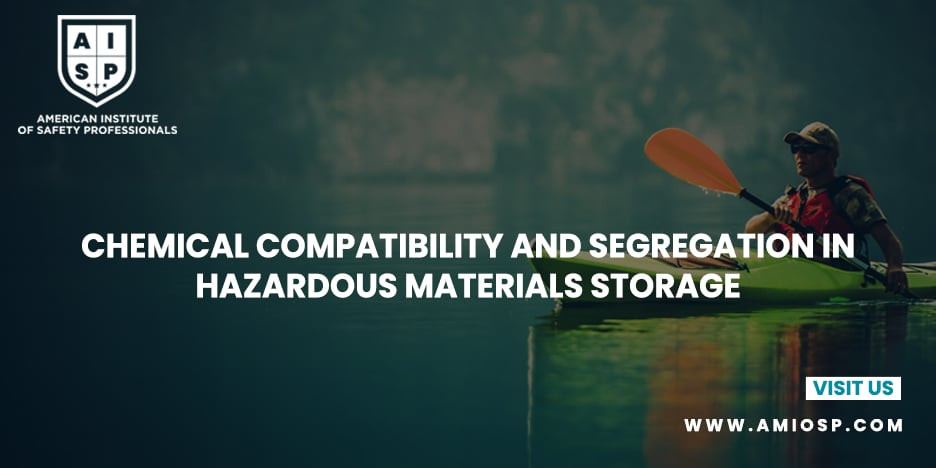Proper storage of hazardous materials is essential to
prevent accidents, minimize risks, and ensure the safety of employees and the
surrounding environment. Chemical compatibility and segregation play a crucial
role in determining how hazardous materials should be stored. In this blog
post, we will explore the importance of chemical compatibility, the principles
of segregation, and best practices for hazardous materials storage.
1. Introduction: Understanding Chemical Compatibility and
Segregation
Chemical compatibility refers to the ability of different
substances to coexist without reacting dangerously with one another. In the
context of hazardous materials storage, it is crucial to consider the potential
reactions and hazards that can arise when incompatible substances come into
contact. Segregation, on the other hand, involves physically separating
incompatible materials to prevent inadvertent mixing and reactions.
2. Hazards of Incompatible Chemicals
Mixing incompatible chemicals can lead to various hazards,
including:
- Chemical
Reactions: Incompatible chemicals may react with one another,
resulting in the release of toxic gases, heat, or even explosions. These
reactions can cause injuries, damage property, and pose serious risks to
personnel.
- Fire
and Explosion Risks: Certain combinations of chemicals can increase
the likelihood of fires or explosions. For example, storing oxidizers in
close proximity to flammable substances can create a dangerous
environment.
- Release
of Hazardous Substances: Incompatibility can cause the leakage or
release of hazardous substances, leading to environmental contamination
and potential harm to human health.
3. Principles of Chemical Segregation
To ensure safe storage, it is essential to segregate
hazardous materials based on their compatibility. The following principles can
guide effective segregation:
- Separate
Incompatible Classes: Different hazard classes should be stored
separately to prevent any accidental mixing. Common hazard classes include
flammables, oxidizers, corrosives, reactive, and toxics. Each class has
its own unique properties and reactions, and they should be stored in
designated areas or cabinets.
- Consider
Compatibility Groups: Chemicals within the same hazard class may have
specific compatibility groups based on their reactivity. These groups
provide further guidance on the segregation of chemicals to prevent
reactions. For example, acids and bases should be stored separately to
avoid neutralization reactions.
- Separate
Oxidizers: Oxidizers should be stored separately from flammable
substances to prevent the risk of fire or explosions. This includes
ensuring proper separation between oxidizers and materials such as fuels,
oils, and solvents.
- Avoid
Contamination: Chemicals that can contaminate one another should be
stored separately to avoid cross-contamination. This includes separating
materials that are known to be reactive with one another or those that can
easily contaminate through leakage or spillage.
4. Best Practices for Hazardous Materials Storage
To effectively implement chemical compatibility and
segregation in hazardous materials storage, the following best practices should
be followed:
- Develop
a Storage Plan: Establish a comprehensive storage plan that outlines
the specific storage requirements for different hazard classes and
compatibility groups. This plan should include detailed instructions on
segregation, storage conditions, containment measures, and signage.
- Proper
Labeling and Identification: Clearly label all containers, cabinets,
and storage areas with appropriate hazard labels, warnings, and
identification codes. This ensures easy recognition of the stored
materials and helps personnel identify incompatible substances.
- Provide
Adequate Ventilation: Ensure proper ventilation in storage areas to
prevent the accumulation of hazardous vapors or gases. Adequate
ventilation helps maintain safe storage conditions and minimizes the risk
of chemical reactions or fires.
- Use
Compatible Storage Containers: Select storage containers that are
compatible with the specific hazardous materials being stored. Ensure that
the containers are designed to withstand the properties and potential
reactions of the stored substances.
- Regular
Inspections and Maintenance: Conduct regular inspections of storage
areas to check for any signs of leakage, deterioration, or incompatible
storage. Maintain proper housekeeping practices to prevent the buildup of
spills or contamination.
5. Employee Training and Awareness
Training employees on the importance of chemical
compatibility and segregation is crucial to ensure compliance and safe
practices. Provide comprehensive training programs that cover the
identification of incompatible chemicals, proper storage procedures, emergency
response protocols, and the potential hazards associated with chemical
reactions. Regularly reinforce these training sessions and encourage employees
to report any concerns or issues regarding hazardous materials storage.
6. Conclusion: Prioritizing Chemical Compatibility and
Segregation
Proper storage of hazardous materials is vital to mitigate
risks and protect both employees and the environment. Understanding chemical
compatibility, following the principles of segregation, and implementing best
practices for storage are essential steps in ensuring safe handling and storage
of hazardous materials. By adhering to these guidelines, organizations can
significantly reduce the likelihood of accidents, protect their workforce, and
demonstrate their commitment to responsible and compliant hazardous materials
management.












0 comments
No Comments